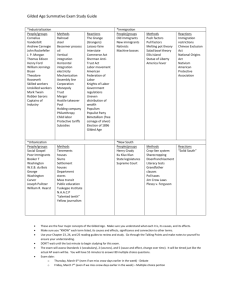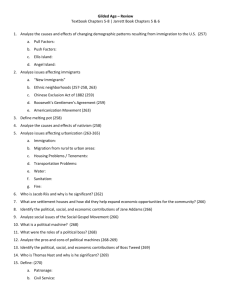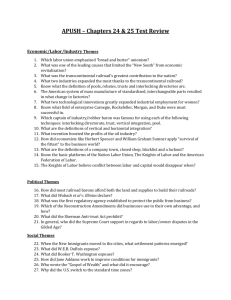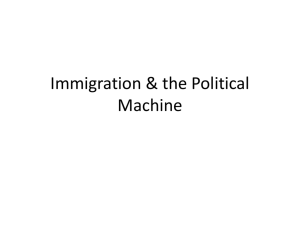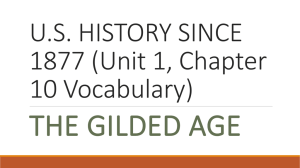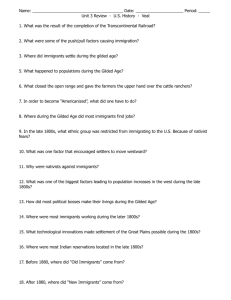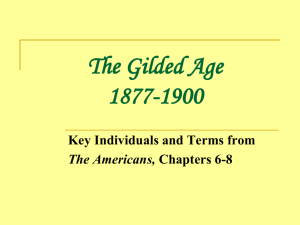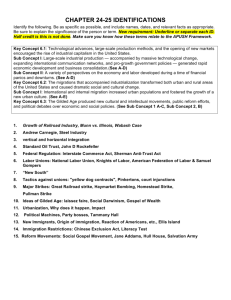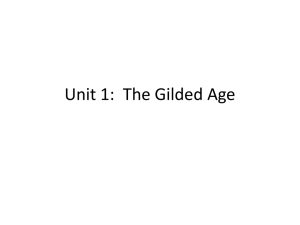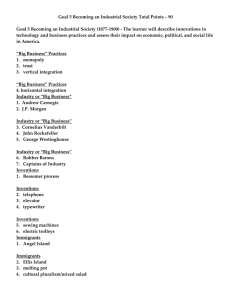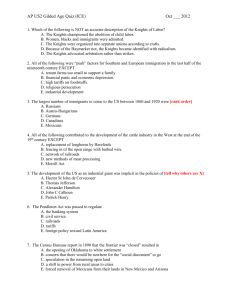APUSH Study Guide – Unit VIII “Industrialization, Urbanization and
advertisement
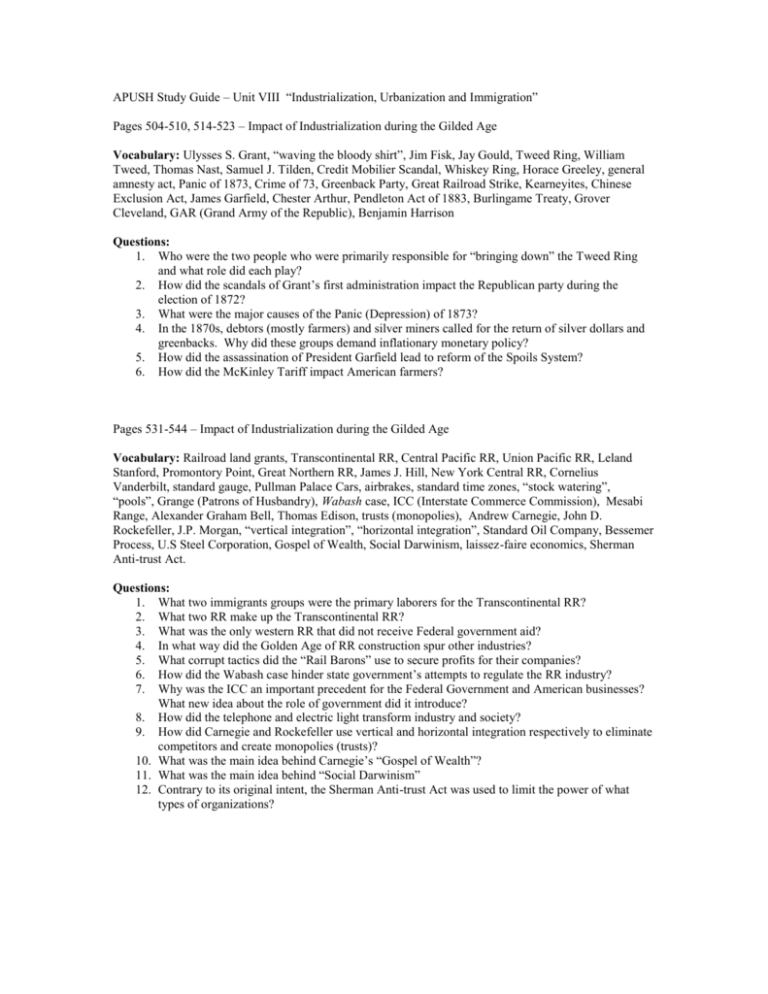
APUSH Study Guide – Unit VIII “Industrialization, Urbanization and Immigration” Pages 504-510, 514-523 – Impact of Industrialization during the Gilded Age Vocabulary: Ulysses S. Grant, “waving the bloody shirt”, Jim Fisk, Jay Gould, Tweed Ring, William Tweed, Thomas Nast, Samuel J. Tilden, Credit Mobilier Scandal, Whiskey Ring, Horace Greeley, general amnesty act, Panic of 1873, Crime of 73, Greenback Party, Great Railroad Strike, Kearneyites, Chinese Exclusion Act, James Garfield, Chester Arthur, Pendleton Act of 1883, Burlingame Treaty, Grover Cleveland, GAR (Grand Army of the Republic), Benjamin Harrison Questions: 1. Who were the two people who were primarily responsible for “bringing down” the Tweed Ring and what role did each play? 2. How did the scandals of Grant’s first administration impact the Republican party during the election of 1872? 3. What were the major causes of the Panic (Depression) of 1873? 4. In the 1870s, debtors (mostly farmers) and silver miners called for the return of silver dollars and greenbacks. Why did these groups demand inflationary monetary policy? 5. How did the assassination of President Garfield lead to reform of the Spoils System? 6. How did the McKinley Tariff impact American farmers? Pages 531-544 – Impact of Industrialization during the Gilded Age Vocabulary: Railroad land grants, Transcontinental RR, Central Pacific RR, Union Pacific RR, Leland Stanford, Promontory Point, Great Northern RR, James J. Hill, New York Central RR, Cornelius Vanderbilt, standard gauge, Pullman Palace Cars, airbrakes, standard time zones, “stock watering”, “pools”, Grange (Patrons of Husbandry), Wabash case, ICC (Interstate Commerce Commission), Mesabi Range, Alexander Graham Bell, Thomas Edison, trusts (monopolies), Andrew Carnegie, John D. Rockefeller, J.P. Morgan, “vertical integration”, “horizontal integration”, Standard Oil Company, Bessemer Process, U.S Steel Corporation, Gospel of Wealth, Social Darwinism, laissez-faire economics, Sherman Anti-trust Act. Questions: 1. What two immigrants groups were the primary laborers for the Transcontinental RR? 2. What two RR make up the Transcontinental RR? 3. What was the only western RR that did not receive Federal government aid? 4. In what way did the Golden Age of RR construction spur other industries? 5. What corrupt tactics did the “Rail Barons” use to secure profits for their companies? 6. How did the Wabash case hinder state government’s attempts to regulate the RR industry? 7. Why was the ICC an important precedent for the Federal Government and American businesses? What new idea about the role of government did it introduce? 8. How did the telephone and electric light transform industry and society? 9. How did Carnegie and Rockefeller use vertical and horizontal integration respectively to eliminate competitors and create monopolies (trusts)? 10. What was the main idea behind Carnegie’s “Gospel of Wealth”? 11. What was the main idea behind “Social Darwinism” 12. Contrary to its original intent, the Sherman Anti-trust Act was used to limit the power of what types of organizations? Pages 523-528, 545-556 Labor Unions Vocabulary: People’s Party (Populists), Homestead Strike, Farmers National Alliance, Depression of 1893, James Duke, Gibson Girl, scabs, injunctions, lockout, yellow-dog contracts, blacklist, National Labor Union (NLU), Knights of Labor, Terrence Powderly, John P. Altgeld, American Federation of Labor, Samuel Gompers, closed shop, Questions: 1. What was the platform of the Populists in 1892? What reforms did they call for? 2. What did the Homestead Strike show about the early labor movement? 3. Why was the Populist Party unable to win over many supporters in the South? 4. What were major causes of the Depression of 1893? 5. Why didn’t the steel industry develop in Birmingham AL, even though there were vast deposits of iron ore and coal in the area? 6. What economic factors led to the development of the textile industry in the Piedmont region of North Carolina? 7. How did the development of large-scale industry affect the lives of American workers? 8. What new job opportunities were opened up for women by the age of industry? 9. How did industrialists limit and weaken the power of labor groups? 10. Why did the American public generally not support laborers and unions in the Gilded Age? 11. What were the goals of the NLU? What event “killed” he National Labor Union? 12. What was the overriding goal of the Knights of Labor? 13. How did the Haymarket Square Riot lead to the demise of the Knights of Labor? 14. What did Samuel Gompers mean by “pure and simple unionism”? How did this approach help the AFL become successful? Hint: see question #10 above. 15. By 1900, Americans began to accept unions in a more favorable light. What were some of the gains made by labor by 1900? Pages 558-574 Urbanization and Immigration Vocabulary: skyscrapers, electric trolleys, Macy’s, Sears, Montgomery Ward, dumbbell tenements, New Immigrants, Ellis Island, “birds of passage”, social gospel movement, Hull House, Jane Addams, settlement houses, Lillian Wald, Florence Kelley, Henry Street Settlement House, nativism, American Protective Association (APA), literacy tests, Salvation Army, YMCA and YWCA, “normal schools”, Chautauqua movement. Questions: 1. What drew many country dwellers to live in cities during the Gilded Age? Which of the pull factors was most important? 2. What problems were caused by the rapid growth of cities and how did urban governments deal with these problems? 3. What kind of discrimination did the New Immigrants face during the latter years of the 19 th century? Why? 4. What were the major push/pull factors that led to an increase in immigration during the Gilded Age? 5. What types of services did settlement house offer to immigrants and urban poor? 6. What were some of the major reasons that labor unions supported immigration restriction? 7. What immigration restrictions did the Federal Government enact before 1900? 8. In what way did Christian Churches respond to the needs of urban poor and immigrants? 9. How did Darwin’s Theory of Evolution impact the nation’s churches? 10. What public school education reforms took place during the latter years of the 19th century?
